CHEVROLET OPTRA 2004 1.G Owners Manual
Manufacturer: CHEVROLET, Model Year: 2004, Model line: OPTRA, Model: CHEVROLET OPTRA 2004 1.GPages: 346, PDF Size: 2.38 MB
Page 241 of 346
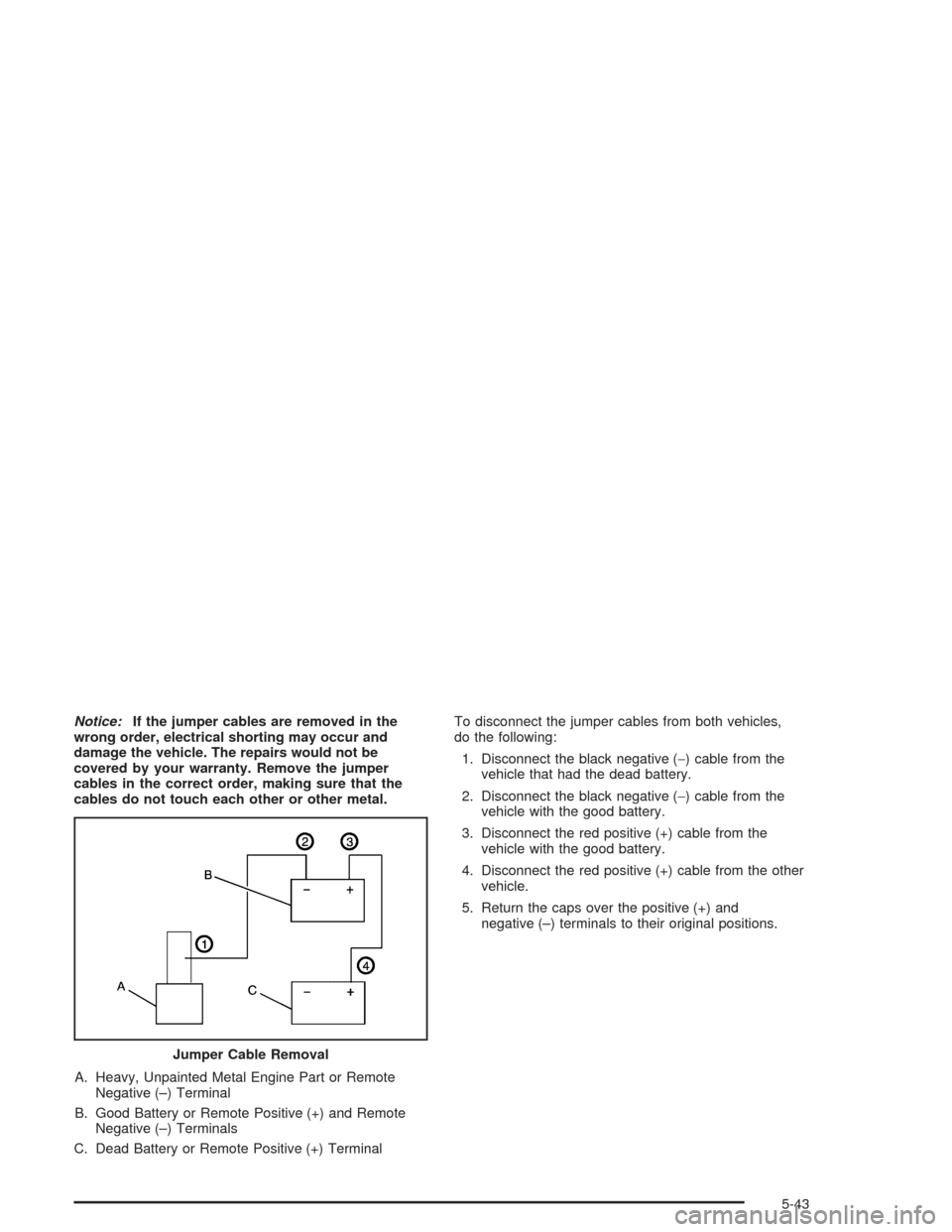
Notice:If the jumper cables are removed in the
wrong order, electrical shorting may occur and
damage the vehicle. The repairs would not be
covered by your warranty. Remove the jumper
cables in the correct order, making sure that the
cables do not touch each other or other metal.
A. Heavy, Unpainted Metal Engine Part or Remote
Negative (–) Terminal
B. Good Battery or Remote Positive (+) and Remote
Negative (–) Terminals
C. Dead Battery or Remote Positive (+) TerminalTo disconnect the jumper cables from both vehicles,
do the following:
1. Disconnect the black negative (−) cable from the
vehicle that had the dead battery.
2. Disconnect the black negative (−) cable from the
vehicle with the good battery.
3. Disconnect the red positive (+) cable from the
vehicle with the good battery.
4. Disconnect the red positive (+) cable from the other
vehicle.
5. Return the caps over the positive (+) and
negative (–) terminals to their original positions.
Jumper Cable Removal
5-43
Page 242 of 346
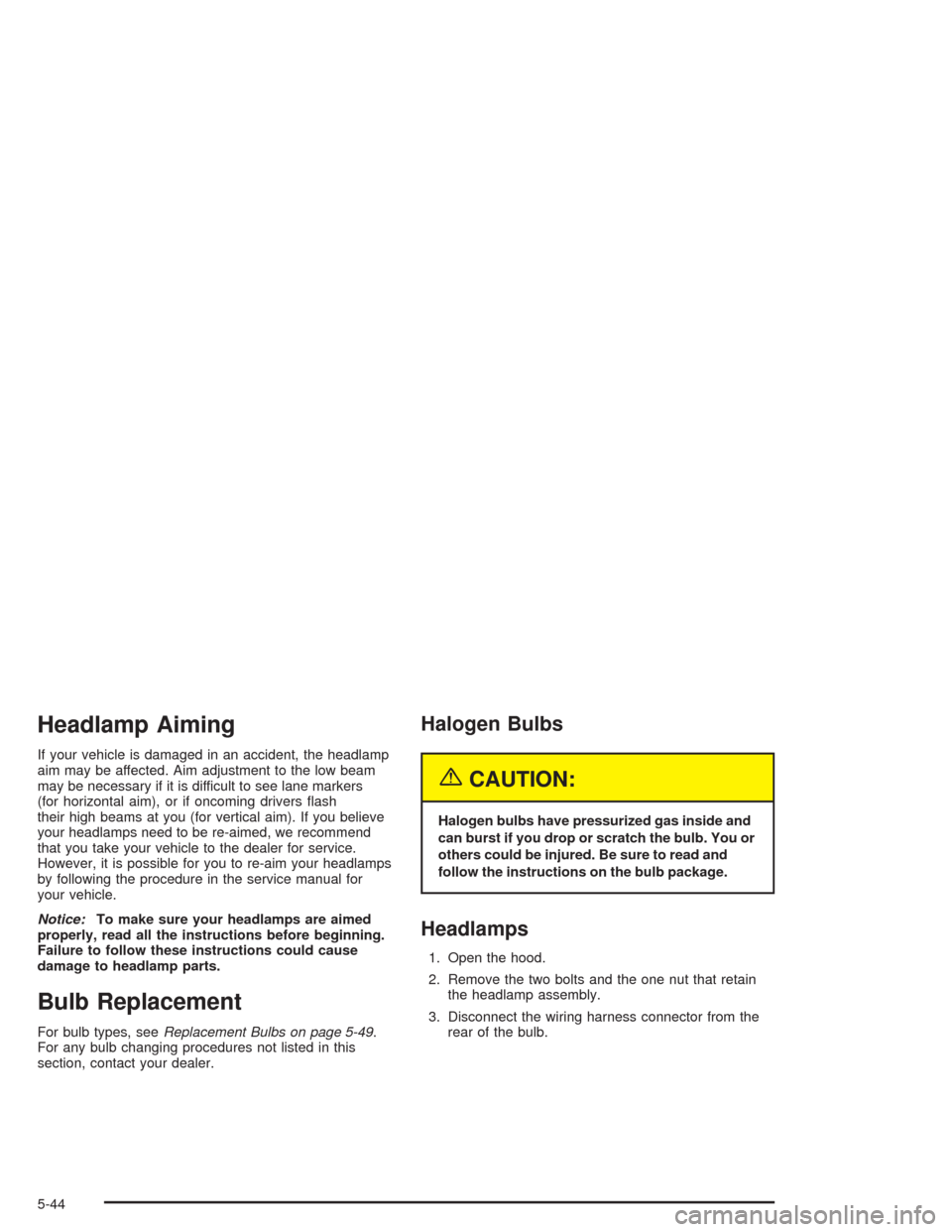
Headlamp Aiming
If your vehicle is damaged in an accident, the headlamp
aim may be affected. Aim adjustment to the low beam
may be necessary if it is difficult to see lane markers
(for horizontal aim), or if oncoming drivers flash
their high beams at you (for vertical aim). If you believe
your headlamps need to be re-aimed, we recommend
that you take your vehicle to the dealer for service.
However, it is possible for you to re-aim your headlamps
by following the procedure in the service manual for
your vehicle.
Notice:To make sure your headlamps are aimed
properly, read all the instructions before beginning.
Failure to follow these instructions could cause
damage to headlamp parts.
Bulb Replacement
For bulb types, seeReplacement Bulbs on page 5-49.
For any bulb changing procedures not listed in this
section, contact your dealer.
Halogen Bulbs
{CAUTION:
Halogen bulbs have pressurized gas inside and
can burst if you drop or scratch the bulb. You or
others could be injured. Be sure to read and
follow the instructions on the bulb package.
Headlamps
1. Open the hood.
2. Remove the two bolts and the one nut that retain
the headlamp assembly.
3. Disconnect the wiring harness connector from the
rear of the bulb.
5-44
Page 243 of 346
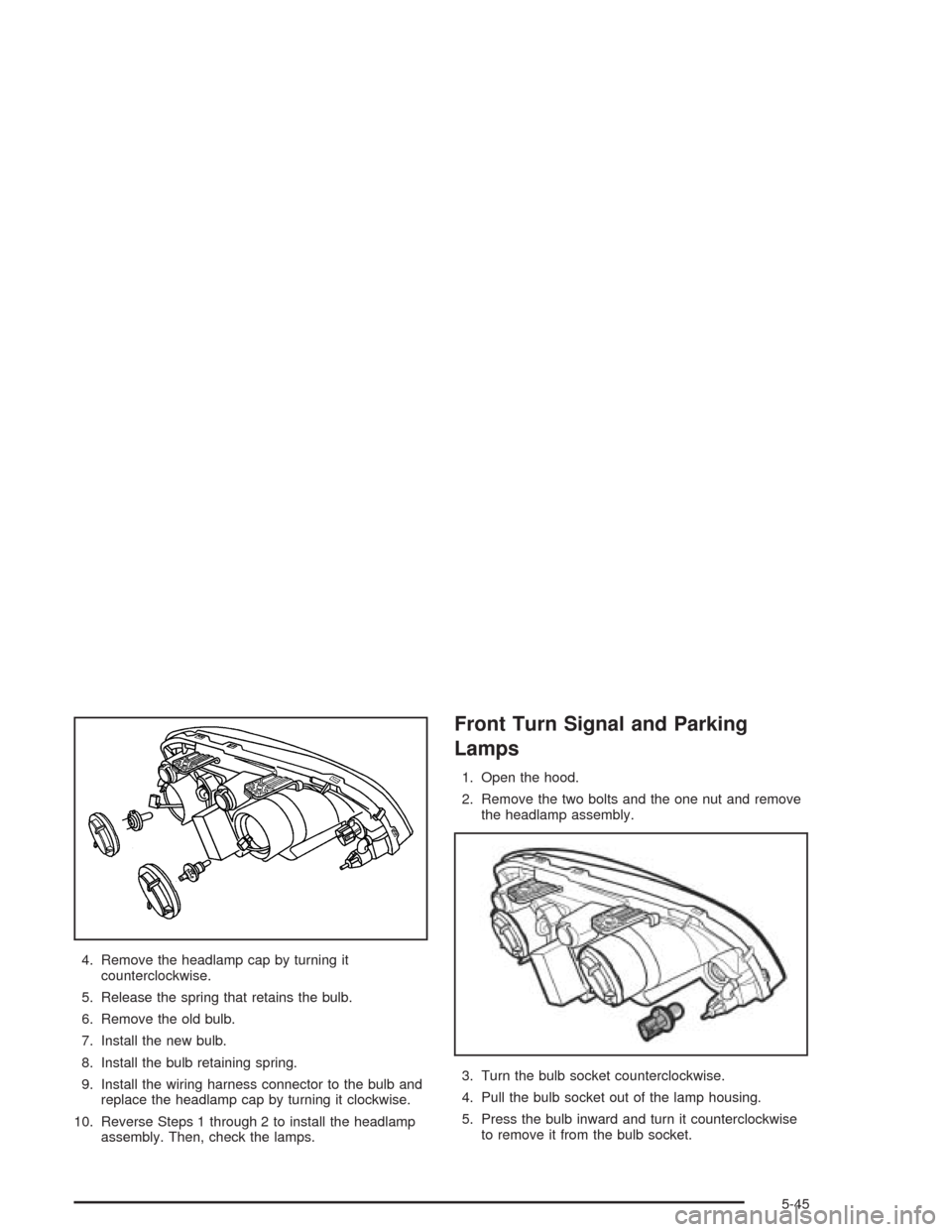
4. Remove the headlamp cap by turning it
counterclockwise.
5. Release the spring that retains the bulb.
6. Remove the old bulb.
7. Install the new bulb.
8. Install the bulb retaining spring.
9. Install the wiring harness connector to the bulb and
replace the headlamp cap by turning it clockwise.
10. Reverse Steps 1 through 2 to install the headlamp
assembly. Then, check the lamps.
Front Turn Signal and Parking
Lamps
1. Open the hood.
2. Remove the two bolts and the one nut and remove
the headlamp assembly.
3. Turn the bulb socket counterclockwise.
4. Pull the bulb socket out of the lamp housing.
5. Press the bulb inward and turn it counterclockwise
to remove it from the bulb socket.
5-45
Page 244 of 346

6. Install the new bulb into the holder by pressing it in
and turning it clockwise.
7. Install the socket into the lamp housing by turning it
clockwise.
8. Reverse Steps 1 through 2 to install the assembly.
Then, check the lamps.
Turn Signal Lamps (Side)
Your vehicle may have this side turn signal lamp.
1. Remove the side turn signal lamp assembly by
pulling it forward.
2. Turn the bulb holder counterclockwise.3. Remove the bulb from the lamp housing by pulling
the bulb straight out of the holder.
4. Install the new bulb into the bulb holder by pushing
in and turning the bulb holder clockwise.
5. Push the side turn signal lamp assembly back into
its original position.
Fog Lamps
1. Disconnect the wiring
harness connector
from the front fog
lamp bulb.
2. Turn the front fog lamp bulb counterclockwise and
remove it.
3. Install the new bulb.
4. Connect the wiring harness connector to the front
fog lamp bulb.
5-46
Page 245 of 346
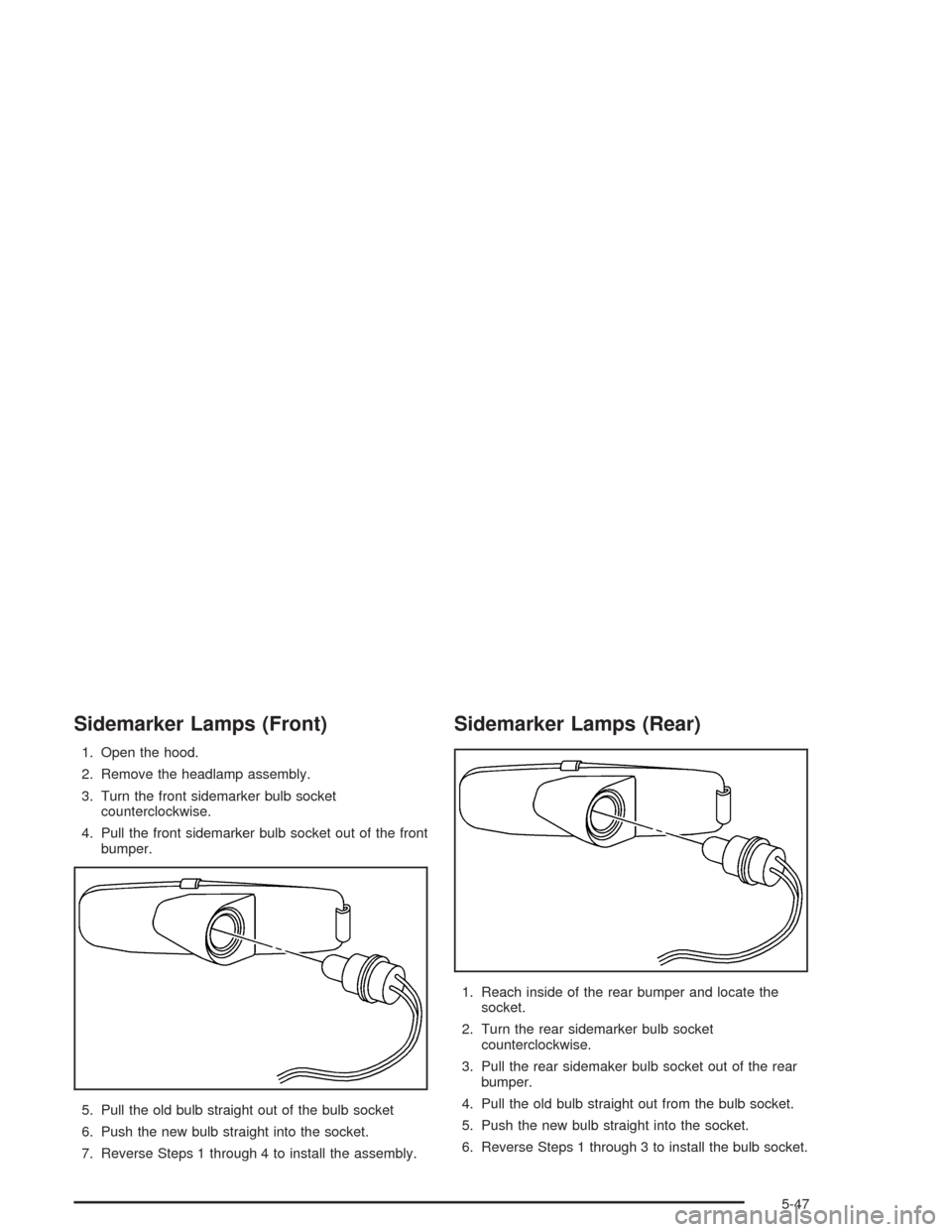
Sidemarker Lamps (Front)
1. Open the hood.
2. Remove the headlamp assembly.
3. Turn the front sidemarker bulb socket
counterclockwise.
4. Pull the front sidemarker bulb socket out of the front
bumper.
5. Pull the old bulb straight out of the bulb socket
6. Push the new bulb straight into the socket.
7. Reverse Steps 1 through 4 to install the assembly.
Sidemarker Lamps (Rear)
1. Reach inside of the rear bumper and locate the
socket.
2. Turn the rear sidemarker bulb socket
counterclockwise.
3. Pull the rear sidemaker bulb socket out of the rear
bumper.
4. Pull the old bulb straight out from the bulb socket.
5. Push the new bulb straight into the socket.
6. Reverse Steps 1 through 3 to install the bulb socket.
5-47
Page 246 of 346
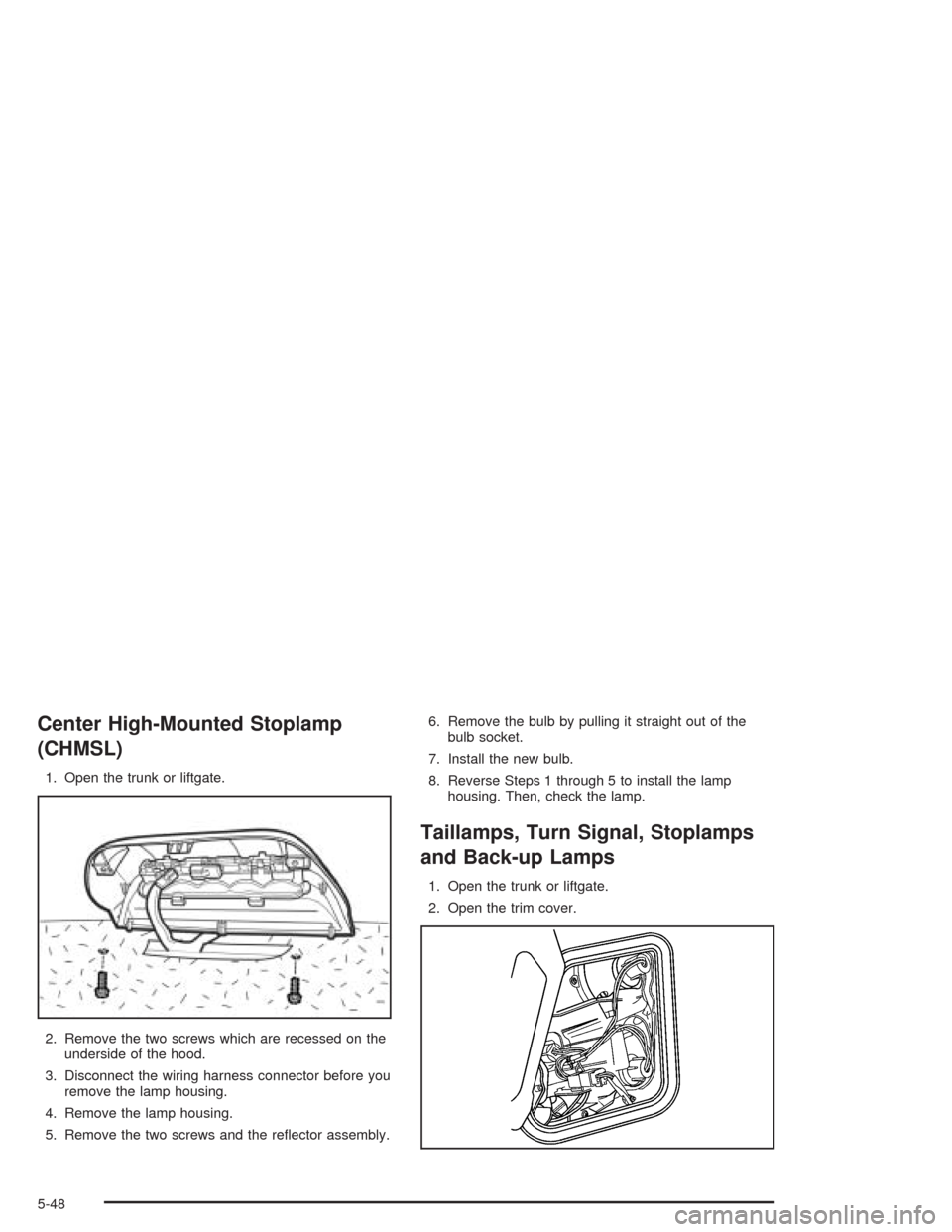
Center High-Mounted Stoplamp
(CHMSL)
1. Open the trunk or liftgate.
2. Remove the two screws which are recessed on the
underside of the hood.
3. Disconnect the wiring harness connector before you
remove the lamp housing.
4. Remove the lamp housing.
5. Remove the two screws and the reflector assembly.6. Remove the bulb by pulling it straight out of the
bulb socket.
7. Install the new bulb.
8. Reverse Steps 1 through 5 to install the lamp
housing. Then, check the lamp.
Taillamps, Turn Signal, Stoplamps
and Back-up Lamps
1. Open the trunk or liftgate.
2. Open the trim cover.
5-48
Page 247 of 346
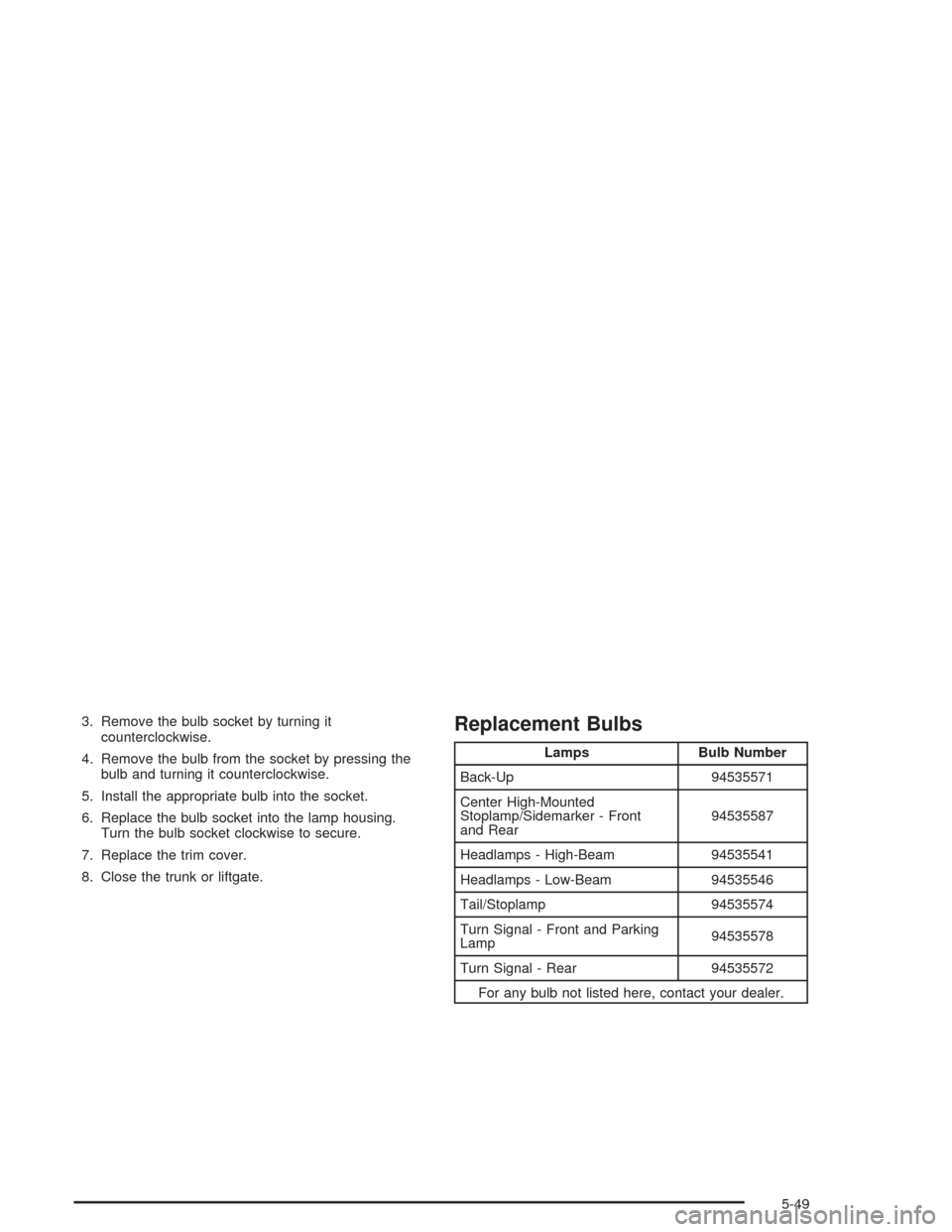
3. Remove the bulb socket by turning it
counterclockwise.
4. Remove the bulb from the socket by pressing the
bulb and turning it counterclockwise.
5. Install the appropriate bulb into the socket.
6. Replace the bulb socket into the lamp housing.
Turn the bulb socket clockwise to secure.
7. Replace the trim cover.
8. Close the trunk or liftgate.Replacement Bulbs
Lamps Bulb Number
Back-Up 94535571
Center High-Mounted
Stoplamp/Sidemarker - Front
and Rear94535587
Headlamps - High-Beam 94535541
Headlamps - Low-Beam 94535546
Tail/Stoplamp 94535574
Turn Signal - Front and Parking
Lamp94535578
Turn Signal - Rear 94535572
For any bulb not listed here, contact your dealer.
5-49
Page 248 of 346
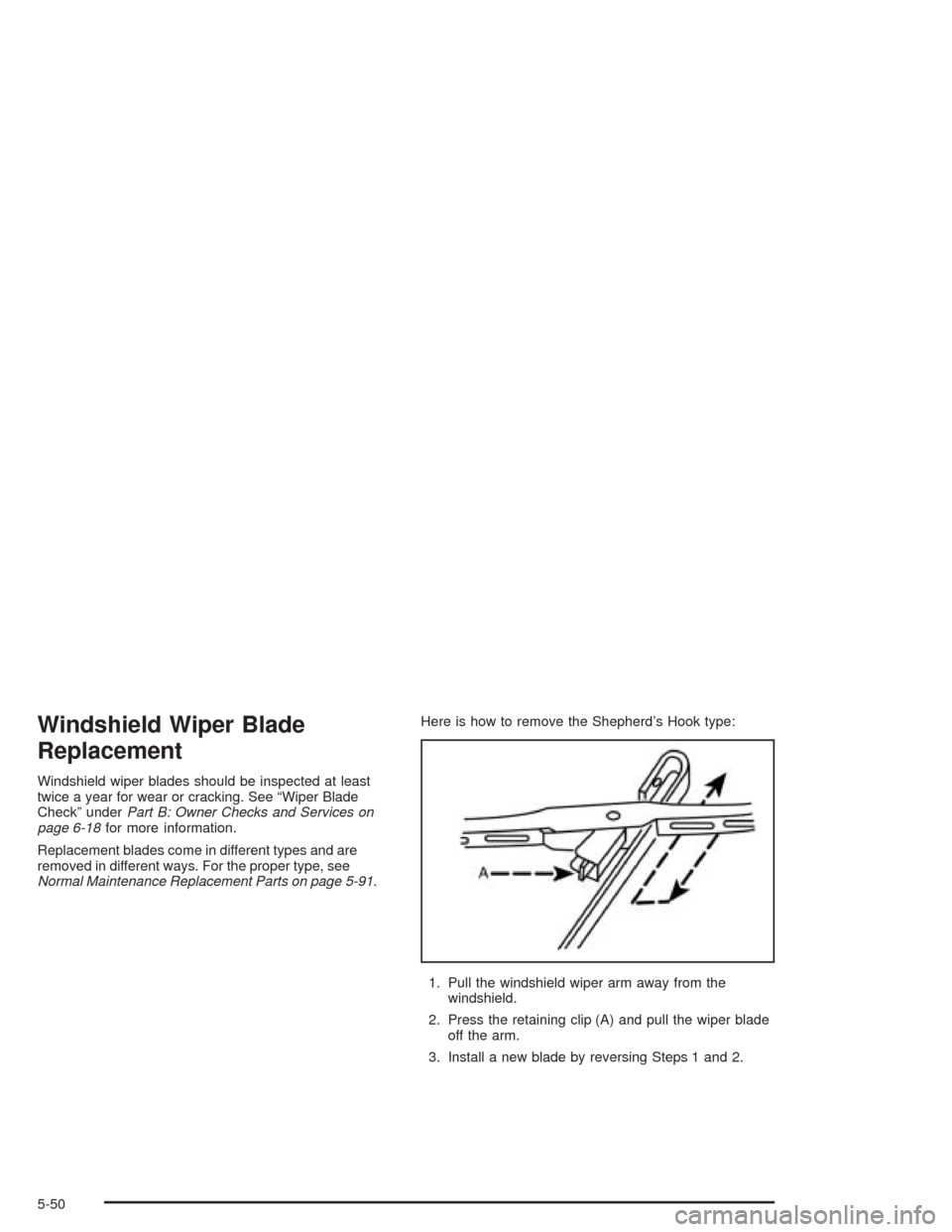
Windshield Wiper Blade
Replacement
Windshield wiper blades should be inspected at least
twice a year for wear or cracking. See “Wiper Blade
Check” underPart B: Owner Checks and Services on
page 6-18for more information.
Replacement blades come in different types and are
removed in different ways. For the proper type, see
Normal Maintenance Replacement Parts on page 5-91.Here is how to remove the Shepherd’s Hook type:
1. Pull the windshield wiper arm away from the
windshield.
2. Press the retaining clip (A) and pull the wiper blade
off the arm.
3. Install a new blade by reversing Steps 1 and 2.
5-50
Page 249 of 346
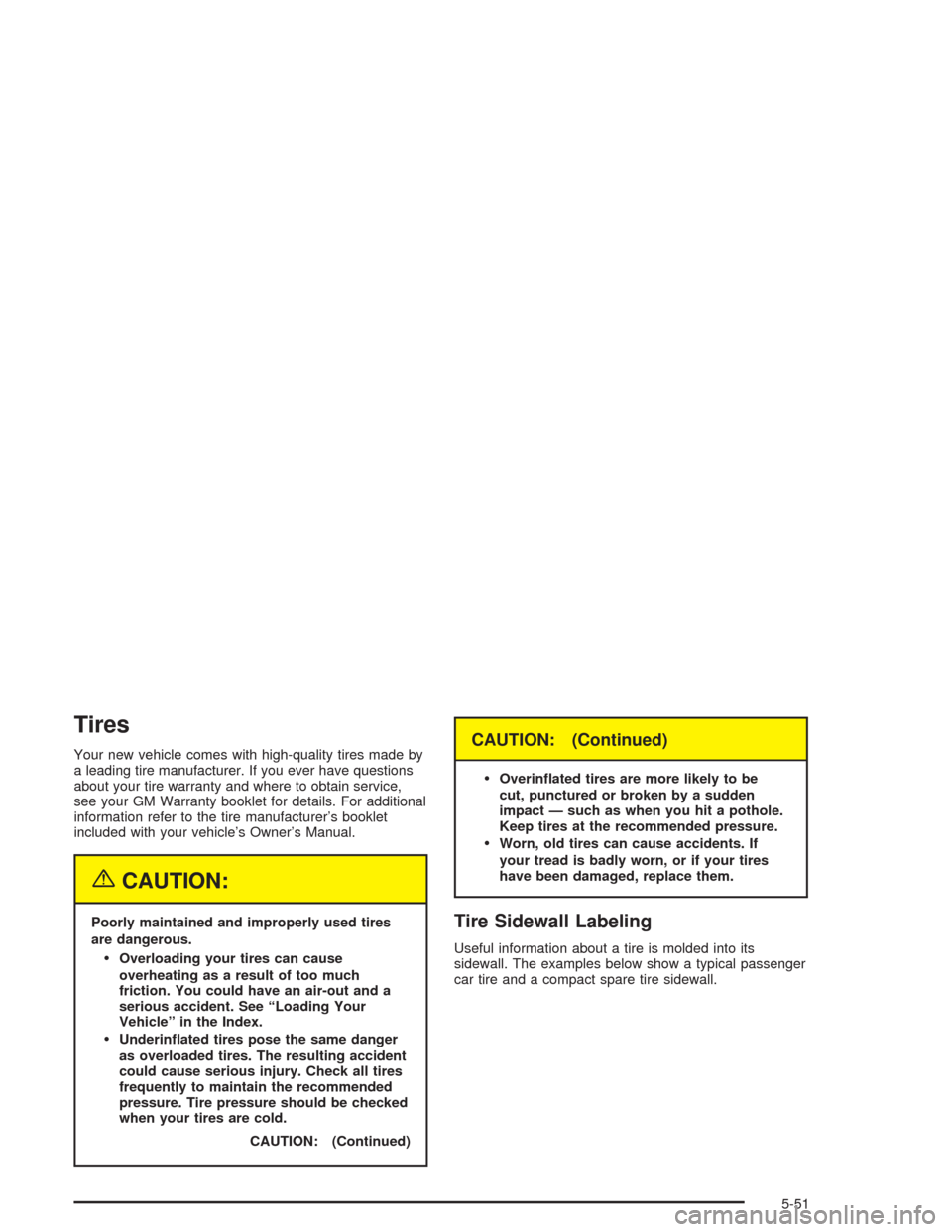
Tires
Your new vehicle comes with high-quality tires made by
a leading tire manufacturer. If you ever have questions
about your tire warranty and where to obtain service,
see your GM Warranty booklet for details. For additional
information refer to the tire manufacturer’s booklet
included with your vehicle’s Owner’s Manual.
{CAUTION:
Poorly maintained and improperly used tires
are dangerous.
Overloading your tires can cause
overheating as a result of too much
friction. You could have an air-out and a
serious accident. See “Loading Your
Vehicle” in the Index.
Underin�ated tires pose the same danger
as overloaded tires. The resulting accident
could cause serious injury. Check all tires
frequently to maintain the recommended
pressure. Tire pressure should be checked
when your tires are cold.
CAUTION: (Continued)
CAUTION: (Continued)
Overin�ated tires are more likely to be
cut, punctured or broken by a sudden
impact — such as when you hit a pothole.
Keep tires at the recommended pressure.
Worn, old tires can cause accidents. If
your tread is badly worn, or if your tires
have been damaged, replace them.
Tire Sidewall Labeling
Useful information about a tire is molded into its
sidewall. The examples below show a typical passenger
car tire and a compact spare tire sidewall.
5-51
Page 250 of 346
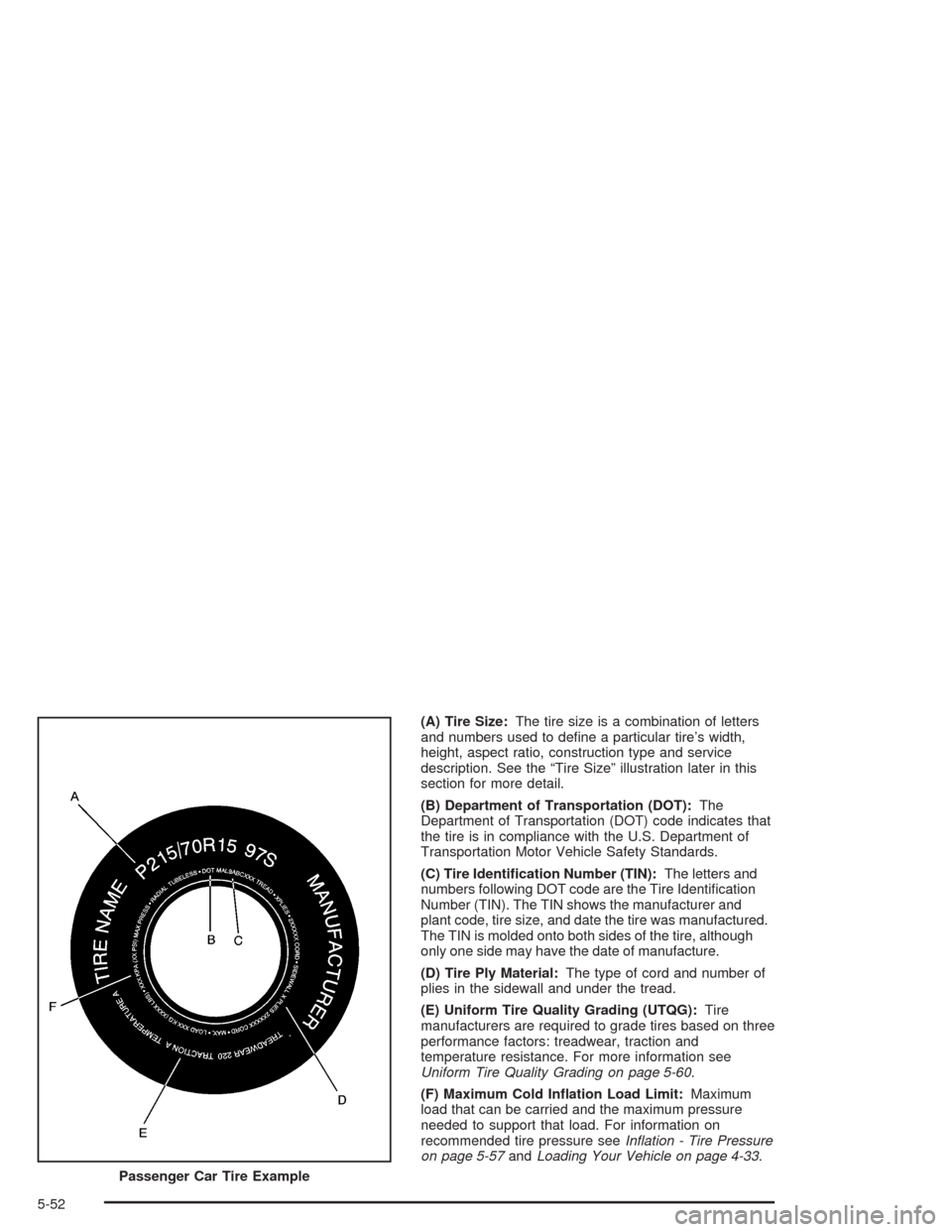
(A) Tire Size:The tire size is a combination of letters
and numbers used to define a particular tire’s width,
height, aspect ratio, construction type and service
description. See the “Tire Size” illustration later in this
section for more detail.
(B) Department of Transportation (DOT):The
Department of Transportation (DOT) code indicates that
the tire is in compliance with the U.S. Department of
Transportation Motor Vehicle Safety Standards.
(C) Tire Identi�cation Number (TIN):The letters and
numbers following DOT code are the Tire Identification
Number (TIN). The TIN shows the manufacturer and
plant code, tire size, and date the tire was manufactured.
The TIN is molded onto both sides of the tire, although
only one side may have the date of manufacture.
(D) Tire Ply Material:The type of cord and number of
plies in the sidewall and under the tread.
(E) Uniform Tire Quality Grading (UTQG):Tire
manufacturers are required to grade tires based on three
performance factors: treadwear, traction and
temperature resistance. For more information see
Uniform Tire Quality Grading on page 5-60.
(F) Maximum Cold In�ation Load Limit:Maximum
load that can be carried and the maximum pressure
needed to support that load. For information on
recommended tire pressure seeInflation - Tire Pressure
on page 5-57andLoading Your Vehicle on page 4-33.
Passenger Car Tire Example
5-52